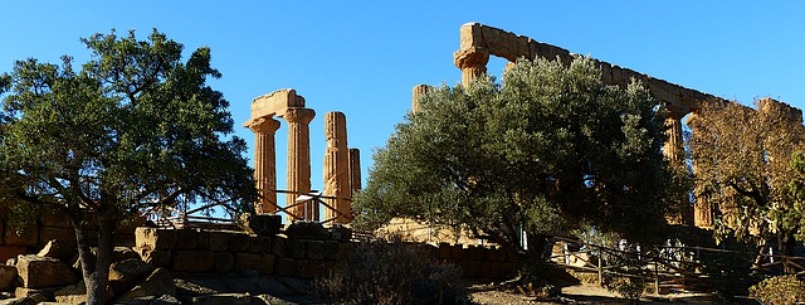First, A Brief History of Sicily
Palermo was founded in the 8th century BC by Phoenician tradesmen around a natural harbor on the northwestern coast of Sicily. The Phoenician name for the city may have been Zîz, but Greeks called it Panormus, meaning all-port, because of its exceptional natural harbor. Palermo remained a Phoenician city until the First Punic War (264-241 BC) when Sicily fell under Roman rule. The Roman period was one of comparative calm, Palermo coming under the provincial administration of Syracuse. When the Roman Empire was split, Sicily and Palermo went under the rule of the Eastern Byzantine Empire.
By 878, all of Sicily, except for a few Byzantine enclaves near Taormina, was controlled by the Saracens. In 905, they captured those too. The Arab rulers moved Sicily’s capital to Palermo, where it has been ever since. Under Muslim dominion, Palermo became an important commercial and cultural center; a flourishing city broadly known in all the Arab world, it is said to have more than 300 mosques. But they were also years of tolerance: Christians and Jews were permitted to follow their credo. In 1060 the Normans launched a crusade against the Muslim emirate of Sicily, taking Palermo on January 10, 1072, and the whole island by 1091. The resulting blend of Norman and Arab culture fostered a unique hybrid style of architecture, as can be seen in the Palatine Chapel, the Church San Giovanni Degli Eremiti (see picture above), and the Zisa. In 1194 Sicily fell under the control of the Holy Roman Empire. Palermo was the preferred city of Emperor Frederick II. After an interval of Angevin rule (1266-1282), Sicily came under the house of Aragon and later, in 1479, the kingdom of Spain.

Sicily’s unification (1734) with the Bourbon-ruled kingdom of Naples as the kingdom of the Two Sicilies inflicted a devastating blow on the elite of Palermo, as the city was reduced to just another provincial town, the royal court residing in Naples. Palermo rebelled in 1848 and held out against the Neapolitan crown until May 1849. The Italian Risorgimento and Sicily’s annexation (1860) to the kingdom of Italy gave Palermo a second chance. It was once again the administrative center of Sicily, and there was a specific economic and industrial development. Palermo survived almost the entire fascist period unscathed, but during the Allied invasion of Sicily in July 1943, it suffered substantial damage. The importance of Palermo got another boost when Sicily became an autonomous region with extensive self-rule (1947). But any improvement was thwarted by the rising power of the Mafia, which still today is a dramatic feature of the city, as well as the whole of Southern Italy.
Best Archeological Sites Sicily
Siracusa
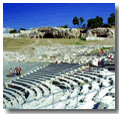 Siracusa was founded by the Greeks in 733BC. The rich remains of the Neapolis Archeological Area, established in 1955, illustrate the great economic and cultural importance of the city in the past. The most relevant ruins are the Latomie (stone quarries) with the impressive Ear of Dionysus and the beautiful garden of palm and citrus fruit trees; the Tomb of Archimedes, a famous scientist of antiquity; and the Greek Theater (5th century BC). A visit to the Museo Archeologico Regionale “Paolo Orsi” in Syracuse will assist in fully understanding the past of this fascinating Sicilian city.
Siracusa was founded by the Greeks in 733BC. The rich remains of the Neapolis Archeological Area, established in 1955, illustrate the great economic and cultural importance of the city in the past. The most relevant ruins are the Latomie (stone quarries) with the impressive Ear of Dionysus and the beautiful garden of palm and citrus fruit trees; the Tomb of Archimedes, a famous scientist of antiquity; and the Greek Theater (5th century BC). A visit to the Museo Archeologico Regionale “Paolo Orsi” in Syracuse will assist in fully understanding the past of this fascinating Sicilian city.
- Highlights: the spectacular Greek Theater is one of the most important ancient theaters in the world. The Istituto Italiano del Dramma Antico performs plays here every other year.
- Address: Via Rizzo/Via Paradiso, Siracusa
- Tel.: (0931) 662 06
- Web site: www.regione.sicilia.it (Italian)
Agrigento
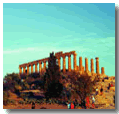 The Valley of the Temples is one of the best kept archeological sites of antiquity and a UNESCO World Heritage Site. It is divided into two main areas: 1) the temples, the Garden of Kolymbetra, the Antiquaria, the early Christian Catacombs in the South; 2) the Archeological Museum, the Church of San Nicola, the Rock Sanctuary of Demeter and the Hellenistic Roman quarter in the North. The temples, all built around the 5th century BC (except for the Temple of Heracles, erected in the 6th century BC), are dedicated to Greek divinities: Olympian Zeus, Heracles, Concord, and Hera. All the temples were burnt by the Carthaginians and later restored by the Romans.
The Valley of the Temples is one of the best kept archeological sites of antiquity and a UNESCO World Heritage Site. It is divided into two main areas: 1) the temples, the Garden of Kolymbetra, the Antiquaria, the early Christian Catacombs in the South; 2) the Archeological Museum, the Church of San Nicola, the Rock Sanctuary of Demeter and the Hellenistic Roman quarter in the North. The temples, all built around the 5th century BC (except for the Temple of Heracles, erected in the 6th century BC), are dedicated to Greek divinities: Olympian Zeus, Heracles, Concord, and Hera. All the temples were burnt by the Carthaginians and later restored by the Romans.
- Highlights: the majestic Temple of Concord is one of the best-preserved and finest Doric temples in the world.
- Address: Passeggiata Archeologica, Agrigento
- Tel.: (0922) 49 72 26
- Web site: www.regione.sicilia.it (Italian)
Selinunte (Trapani)
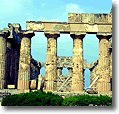
Located on the southwest coast of Sicily in the province of Trapani, Selinunte was founded by the Greeks in the 7th century BC. Its name comes from the word selinon, which means wild fennel, a widely common plant throughout the area. Selinunte flourished for two centuries under Greek domination. Although Agrigento counts better preserved Greek temples, Selinunte boasts more temples, all identified by a letter. The setting over the Mediterranean Sea gives to the archeological ruins a unique display for a suggestive and breathtaking experience.
- Highlights: Temple G (530BC) is the largest of the trio (F, E, G) and Temple C is the most discernible of five (A, B, C, D, and O). Some of the metopes (stone-carved panels) of Temple E are on display at the Museo Archeologico Regionale “Antonino Salinas” in Palermo.
- Address: Zona Archeologica, Selinunte (Trapani)
- Web site: www.regione.sicilia.it (Italian)
Segesta (Trapani)
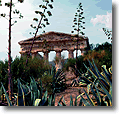
Segesta was founded by the indigenous tribe of the Elymians. This archeological site, with its Doric temple (430/420BC) and an amphitheater, is one of the best-preserved to be found anywhere. The temple is located on the top of a slope in pristine countryside, away from virtually any modern construction. The amphitheater stands on the slopes of Monte Barbaro. A convenient shuttle service takes tourists to and from the amphitheater.
- Highlights: Temple of Segesta and amphitheater.
- Address: Zona Archeologica, Segesta (Trapani)
- Web site: www.regione.sicilia.it (Italian)
Taormina (Messina)
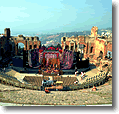
Taormina is Sicily’s most renowned resort. Located in the province of Messina, it hosts a magnificent amphitheater with a breathtaking view of Mount Etna in the background. The theater, built by the Greeks in the 3rd century BC and remodeled by the Romans, is still used today and hosts the famous Taormina Film Festival. A much smaller Roman theater, the Odeon, is to be found near the Church of Santa Caterina.
- Highlights: the Greek-Roman amphitheater.
- Address: Via Teatro Greco, Taormina (Messina)
- Web site: www.regione.sicilia.it (Italian)
Villa Romana Del Casale (Enna)

This luxury villa was built at the end of the 3rd century AD. Its floor is almost entirely covered with beautiful and detailed mosaics with scenes of everyday life and divinities. It is the richest and largest collection of late Roman mosaics in the world. The Villa Romana del Casale is a UNESCO World Heritage Site.
The villa burnt and was covered by a flood around 1161. It was discovered in the 18th century.
- Highlights: the frigidarium (the cold bathroom); the Hall of the Female Gymnasts in Bikinis; corridor with hunting scenes; the Myth of Airon.
- Address: Piazza Armerina (Enna)
Località Casale - Tel.: (0935) 568 00 36
- Fax: (0935) 68 71 83
- Web site: www.villaromanadelcasale.it
Morgantina, Aidone (Enna)
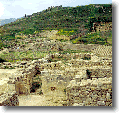
Morgantina was founded by King Morges in the 12th century BC. Six centuries later, the Greeks colonized the city that was destroyed by the Romans during the Punic Wars in 211 BC. Morgantina was rebuilt by the Romans and became a prosperous city, but was abandoned around 30 BC for uncertain reasons.
- Highlights: the Amphitheater (3rd Century BC); ruins of a temple dedicated to Demeter and Kore.
- Address: Aidone (Enna)
- Web site: www.regione.sicilia.it (Italian)
Motya (Trapini)
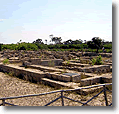
Motya, founded by the Carthaginians in the 8th century BC, is situated in the small island of Mozia south of Trapani and north from the coast of Marsala. Dionysus the Elder, tyrant of Syracuse, sacked the town in 398 BC.
- Highlights: the Cappiddazzu Sanctuary (7th BC); the old city walls.
- Address: Motya, Trapani
- Tel.: (0923) 71 25 98
Giardini-Naxos (Messina)
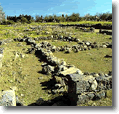
The town of Naxos was founded in 734 BC. Destroyed by Dionysus in 403 BC, it lost its importance and turned into a small village. Nowadays, visitors can still see some of the ruins of the Apollo Archegetes temple and the city walls. A nearby museum holds artifacts of the classic age.
- Highlights: ruins of the classic age in the Archeological Park.
- Address: Giardini Naxos (Messina), Via Lungomare Schisò
- Tel. & Fax: (0942) 510 01
- Web site: www.regione.sicilia.it
Tyndaris (Messina)
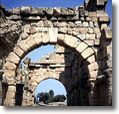
Tyndaris, founded by Dyonisus in 396 BC, was one of the last Greek colonies in Sicily. It was invaded by the Carthaginians led by Hannibal in 264 BC and rebuilt by the Romans ten years later. The beauty of Tyndaris is still present in its ruins. The Greek-Roman theater with its spectacular setting over the Tyrrhenian Sea is used for shows and plays in the summertime.
- Highlights: Greek-Roman Theater (5th century BC) and Agorà (1st century BC) .
- Address: Zona Archeologica, Tindari (Messina)
- Tel.: (0921) 42 15 47
- Web site: www.regione.sicilia.it (Italian)
Lipari (Messina)
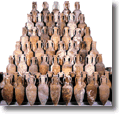
Lipari is the largest island of the Aeolian Islands, off of the northeast coast of Sicily in the Messina province. It boasts an Archeological Museum with a castle and an archeological park in the back. The oldest part of the castle was built by the Greeks.
- Highlights: classic archeological section of the museum; submarine archeology.
- Address: Via del Castello, Lipari (Messina)
- Tel.: (090) 988 01 74/988 05 94
- Fax: (090) 98 80 17
- Web site: www.regione.sicilia.it (Italian)
Pantalica (Siracusa)
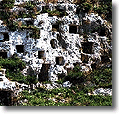
The Necropolis of Pantalica contains over 5,000 tombs carved into the rocks near open stone quarries, most of them dating from the 13th to 7th century BC. Pantalica was declared a UNESCO World Heritage Site in 2005.
- Highlights: the Necropolis.
- Address: Zona Archeologica, Pantalica (Siracusa)
Solunto, Bagheria (Palermo)
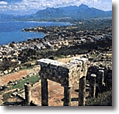
Located east of Palermo, Solunto was founded in the 7th century BC and expanded by the Greeks in 396BC. Conquered by the Romans, the town was abandoned for unknown reasons in the 3rd century AD.
- Highlights: Roman ruins overlooking the Mediterranean Sea.
- Address: Solunto, Bagheria (Palermo)
